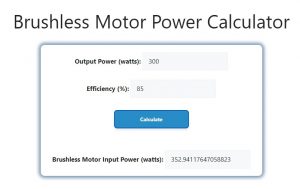About Brushless Motor Power Calculator (Formula)
Brushless motors have revolutionized various applications due to their efficiency and longevity. However, understanding the power requirements for these motors is crucial for ensuring optimal performance and reliability. The Brushless Motor Power Calculator is a valuable tool that helps engineers and hobbyists determine the input power needed based on output power and efficiency. This article will explain the formula used, how to utilize the calculator, provide an example, and address common questions related to brushless motor power calculations.
Formula
The formula for calculating the input power (Pi) for a brushless motor is:
Pi = Po / (E / 100)
Where:
- Pi represents the input power in watts.
- Po is the output power in watts.
- E is the efficiency of the motor expressed as a percentage.
How to Use
- Determine Output Power: First, you need to know the output power (Po) of your brushless motor. This information is typically provided in the motor specifications.
- Identify Efficiency: Next, find the efficiency (E) of the motor, which is usually available from the manufacturer or technical documentation.
- Input Values: Substitute the values of output power and efficiency into the formula: Pi = Po / (E / 100).
- Calculate Input Power: Perform the calculation to determine the input power (Pi) required for your brushless motor.
Example
Let’s calculate the input power required for a brushless motor with the following specifications:
- Output Power (Po): 300 watts
- Efficiency (E): 85%
Using the formula:
Pi = Po / (E / 100)
Pi = 300 / (85 / 100)
Pi = 300 / 0.85
Pi ≈ 352.94 watts
In this example, approximately 352.94 watts of input power are required for the motor to achieve 300 watts of output power at 85% efficiency.

FAQs
- What is a brushless motor?
A brushless motor is an electric motor that operates without brushes, providing higher efficiency and longevity compared to brushed motors. - Why is input power important for brushless motors?
Understanding input power helps in selecting the appropriate power supply and ensures optimal performance of the motor. - How is motor efficiency defined?
Efficiency is defined as the ratio of output power to input power, expressed as a percentage. - What factors can affect motor efficiency?
Factors include design, load conditions, temperature, and the quality of materials used in the motor. - Can I use this calculator for other types of motors?
This calculator is specifically designed for brushless motors; other motor types may require different formulas. - How can I improve the efficiency of my brushless motor?
Proper maintenance, using high-quality components, and optimizing load conditions can improve efficiency. - Is there a standard efficiency range for brushless motors?
Yes, brushless motors typically have efficiencies ranging from 70% to over 95%, depending on the design and application. - What is the relationship between voltage and power in a brushless motor?
Voltage is one of the factors that influence power; however, input power also depends on current and efficiency. - What is the difference between output power and input power?
Output power is the useful power produced by the motor, while input power is the total power consumed to achieve that output. - How do I measure the output power of my motor?
Output power can be measured using a dynamometer or calculated based on the motor’s load and speed. - What happens if the input power exceeds the motor’s capacity?
Exceeding the motor’s capacity can lead to overheating, reduced efficiency, and potential damage to the motor. - Can I use the calculator for a multi-phase brushless motor?
Yes, the same principles apply, but make sure to account for the specifics of multi-phase configurations. - What role do controllers play in brushless motors?
Controllers regulate the power supplied to the motor, affecting its performance and efficiency. - How often should I check motor efficiency?
It is advisable to check efficiency periodically, especially if the motor is subjected to varying load conditions. - What is a good practice for optimizing brushless motors?
Regular maintenance and monitoring performance parameters can help optimize efficiency. - Can external factors like temperature affect efficiency?
Yes, higher temperatures can reduce efficiency, so ensuring proper cooling is essential. - How do I find the efficiency rating of my motor?
The efficiency rating is typically provided in the motor’s datasheet or specifications from the manufacturer. - Is there a minimum efficiency standard for brushless motors?
While there are no universal standards, many manufacturers aim for efficiency levels above 70% to 80%. - What is the importance of choosing the right power supply?
A suitable power supply ensures that the motor receives adequate input power without exceeding its specifications. - How can I ensure accurate calculations?
Make sure to use precise values for output power and efficiency to achieve accurate input power calculations.
Conclusion
The Brushless Motor Power Calculator is a vital tool for understanding the power requirements of brushless motors. By using the formula Pi = Po / (E / 100), you can determine the necessary input power for achieving desired output performance. This knowledge is crucial for engineers, hobbyists, and anyone involved in designing or operating brushless motors, ensuring they operate efficiently and reliably in various applications. Regular assessments and proper maintenance will further enhance motor performance and longevity.